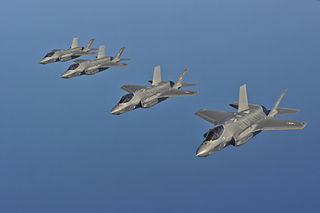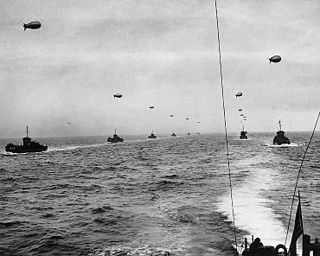The term Interdict may refer to:
Contents
| Look up interdict or interdictum in Wiktionary, the free dictionary. |
The term Interdict may refer to:
| Look up interdict or interdictum in Wiktionary, the free dictionary. |
| | This disambiguation page lists articles associated with the title Interdict. If an internal link led you here, you may wish to change the link to point directly to the intended article. |

A bomber is a combat aircraft designed to attack ground and naval targets by dropping air-to-ground weaponry, launching torpedoes, or deploying air-launched cruise missiles. The first use of bombs dropped from an aircraft occurred in the Italo-Turkish War, with the first major deployments coming in the First World War and Second World War by all major airforces causing devastating damage to cities, towns, and rural areas. The first purpose built bombers were the Italian Caproni Ca 30 and British Bristol T.B.8, both of 1913. Some bombers were decorated with nose art or victory markings.
An interdictor is a type of attack aircraft that operates far behind enemy lines, with the express intent of interdicting the enemy's military targets, most notably those involved in logistics. The interdiction prevents or delays enemy forces and supplies from reaching the battlefront; the term has generally fallen from use. The strike fighter is a closely related concept, but puts more emphasis on air-to-air combat capabilities as a multirole combat aircraft. Larger versions of the interdictor concept are generally referred to as penetrators.
In Catholic canon law, an interdict is an ecclesiastical censure, or ban that prohibits persons, certain active Church individuals or groups from participating in certain rites, or that the rites and services of the church are banished from having validity in certain territories for a limited or extended time.

Air interdiction (AI), also known as deep air support (DAS), is the use of preventive tactical bombing and strafing by combat aircraft against enemy targets that are not an immediate threat, in order to delay, disrupt, or hinder later enemy engagement of friendly forces. It is a core capability of virtually all military air forces, and has been conducted in conflicts since World War I.

Operation Strangle was a series of air interdiction operations during the Italian Campaign of World War II by the United States Fifteenth and Twelfth Air Forces to interdict German supply routes in Italy north of Rome from 19 March 1944 to 11 May 1944. Its aim was to prevent essential supplies from reaching German forces in Central Italy and compel a German withdrawal. The strategic goal of the air assault was to eliminate or greatly reduce the need for a ground assault on the region. The Allies failed in the overly ambitious objective of the campaign, namely the forced withdrawal of German forces from the Gustav Line, but the air interdiction seriously complicated the German conduct of defensive operations and played a major role in the success of the subsequent Allied ground assault Operation Diadem.

A multirole combat aircraft (MRCA) is a combat aircraft intended to perform different roles in combat. A multirole fighter is a multirole combat aircraft which is, at the same time, also a fighter aircraft; in other words, an aircraft whose various roles include, among others, the role of air-to-air combat.
National Treasury Employees Union v. Von Raab, 489 U.S. 656 (1989), was a United States Supreme Court case involving the Fourth Amendment and its implication on drug testing programs. The majority of the Court upheld the drug testing program in United States Customs Service.
A prize crew is the selected members of a ship chosen to take over the operations of a captured ship. Prize crews were required to take their prize to appropriate prize courts, which would determine whether the ship's officers and crew had sufficient cause to have the value of the prize awarded to them.
Panzergruppe Guderian is a board wargame published by Simulations Publications, Inc. in Strategy & Tactics magazine issue 57 in 1976.
The Battle of Pooneryn, was a battle between the militant Liberation Tigers of Tamil Eelam and the Sri Lankan military during the Sri Lankan Civil War for control of the military base in Pooneryn in northern Sri Lanka from 11 November to 14 November 1993.

A line of communication is the route that connects an operating military unit with its supply base. Supplies and reinforcements are transported along the line of communication. Therefore, a secure and open line of communication is vital for any military force to continue to operate effectively. Prior to the advent of the use of telegraph and radio in warfare, lines of communication were also the routes used by despatch riders on horseback and runners to convey and deliver orders and battle updates to and from unit commanders and headquarters. Thus, a unit whose lines of communication were compromised was vulnerable to becoming isolated and defeated, as the means for requesting reinforcements and resupply is lost. The standard military abbreviation is LOC, or SLOC for Sea line of communication or ALOC for air line of communication.

USS Interdictor (AGR/YAGR-13) was a Guardian-class radar picket ship, converted from a Liberty Ship, acquired by the US Navy in 1954. She was reconfigured as a radar picket ship and assigned to radar picket duty in the North Pacific Ocean as part of the Distant Early Warning Line.

Natives Act, Act No 64 of 1956, formed part of the apartheid system of racial segregation in South Africa. It deprived Africans of the right to appeal to the courts by means of an interdict or any legal process against forced removals.
In Scots law, an interdict is a court order to stop someone from breaching someone else's rights. They can be issued by the Court of Session or a Sheriff Court. The equivalent term in England is an injunction. A temporary interdict is called an interim interdict. A court will grant an interim interdict if there is a prima facie case and on the balance of convenience the remedy should be granted. Breaching an interdict can result in a fine or imprisonment.
Operation Strangle was a U.S. Air Force (USAF) bombing campaign of the Korean War. In Summer 1951, as the war bogged down into mutual defensive ground warfare characterized by trench warfare, United Nations close air support found fewer and poorer targets for its fighter-bombers. The USAF turned to interdiction of Korean lines of communication in an effort to cut the communist supply lines.
Operation Desert Rat was a diversionary attack by a Laotian irregular regiment upon the crucial communist supply line, the Ho Chi Minh trail. Carried out by the Central Intelligence Agency sponsored Groupement Mobile 33, the Desert Rat offensive struck the rear of the 50,000 North Vietnamese troops combating Operation Lam Son 719 beginning on 16 February 1971. With 16 daily tactical air sorties and airborne forward air controllers available, the Desert Rat guerrillas used their hilltop position near Moung Phine to spot targets for bombing. It also raided, skirmishing 110 times, killing 121 communist soldiers, and sowing 1,500 mines along North Vietnamese lines of communication. On 20 March, it was assaulted by two communist battalions. The major threat of Lam Son 719 ended, leaving the communists free to deal with the minor one of Desert Rat. However, the guerrillas split into three columns and exfiltrated by 3 April 1971. The Royal Lao Government had lost control of the strategic Bolovens Plateau to the communist invaders.
Operation Sinsay was a Royal Lao Government offensive of the Laotian Civil War. The planned offensive was pre-empted by prior moves by the opposing People's Army of Vietnam (PAVN); they struck on 6 March 1972. Although the Communist attack reached Laongam, 21 kilometers from Pakxe and the Thai border, and the defending Royalist battalions there were reassigned to fight in Operation Strength on the Plain of Jars, monarchist guerrillas were able to interdict Communist supply lines and force a Vietnamese retreat by the end of March 1972.
The Battle of Hồng Ngự took place from March to 4 May 1973 when North Vietnamese forces attacked the border town of Hồng Ngự in Dong Thap Province in order to interdict supply convoys into Cambodia. The attack was defeated by South Vietnamese forces assisted by United States bombing of North Vietnamese base areas in Cambodia.

The Civic Warriors of Maruleng (CWM) is a political party based in Limpopo, South Africa.